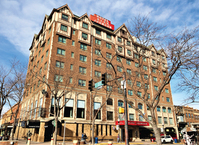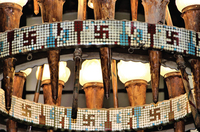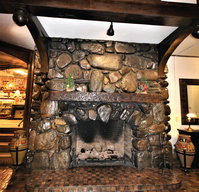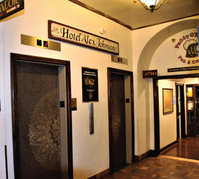This past December my oldest daughter graduated from South Dakota State University’s Nursing program in Rapid City, South Dakota where she has been for the past two and a half years. She recommended that we book our stay at the Hotel Alex Johnson for convenience, as the graduation ceremony would be held at the Elks Theater directly across the street and the reception would be just a block down the street at the Hay Camp Brewery. I had always wanted to stay at the Hotel Alex Johnson and had heard that it had a lot of history to it. As this was a quick trip of only a few days and I was focused on my daughter graduating I had not done any research on the hotel prior to staying there and I wished I had!
We arrived in Rapid City and checked into the hotel late in the afternoon on a Sunday. We were greeted with warm smiles and a helpful bellhop who loaded our luggage on a cart to take up to our room. I was asked if I wanted to stay on the sixth or the eighth floor and responded that it didn’t matter. Once again, my regret of not doing a little research on the hotel prior to would set in later that I should’ve requested a room on the eighth floor. The young man led us to the tiny elevator and once the door opened, I thought no way were the three of us and the luggage cart going to fit in there, we just barely did, and we proceeded up to the sixth floor. After unpacking our luggage and getting cleaned up, we wanted to do some exploring of the hotel also a bit of the downtown as this was the only free time we would have. I grabbed my camera, and the family and I headed down to the lobby to have a look around.
Hanging from the ceiling in the center of the lobby is a chandelier of such uniqueness. I don’t know what to think as I focus on the rings of the chandelier which are made of tiles and there looks to be swastika symbols on them. I question this and point it out to my sister, the receptionist over hears me and explains the true meaning of the swastika symbol and hands me the hotel’s brochure full of information on the history of the hotel and the features within. This one of a kind chandelier made of wood, copper and glazed tile is suspended with chains and war spears adorn the top. It has hung from decorative rafters for over 80 years. The fixture is “teepee shaped and made of copper clad wooden rings. These rings are decorated in authentic Sioux patterns. The symbol resembling the swastika, long used by Native Americans since prehistoric times is present on the glazed tiles adorning the inside and outside rings. The swastika is one of the most ancient of all symbols and used as a symbol for peace, life and good luck. It represented the revolving sun, fire or life. Lighted copper torches are throughout the rings, providing the primary light source for the lobby. The Sioux symbols are through out the hotel and present on the lobby floor tiles is the “Sacred Four Directions”. The Lakota Sioux people believe their four sacred powers are derived from the four directions. The north (white) is a symbol for the “Cleansing Snow”. The east (red) is the home of the “Morning Star”, which gives us “Daybreak Knowledge”. The south (yellow) is the home of “Warm Winds”, which replenishes the growth of the land. The “Thunder Being”, at home in the west (black) gives strength and power in time of trouble. Looking upward to the ceiling are large wooden rafters and the Sioux designs are between the open beams, using bright colors. These patterns are of the traditional “box and border” design. Eight plaster-cast busts of Indian men hold the beams crossing the high ceiling. I turn towards the fireplace and snap a few shots. Looking closer I see there are some etching in the wooden mantle. I refer to the hotel’s brochure as to the meaning of this. The mantle is decorated with the brands of local ranchers. The fireplace is made of Black Hills stone and is one of three similarly designed in the world. The huge rock chosen for the keystone was carefully selected for its resemblance to a buffalo head. High up on the wall on one side of the fireplace is a large painting of Alex Johnson and on the other side are
two buffalo heads. I ask about the balcony and the carved wooden railing and the receptionist clarifies that that is the second floor and directs me to the stairs. The mezzanine bannister was carefully cut and stained by wood craftsmen. From this height you get a clear picture of the lobby and the overall magnitude of its size and the architecture and Lakota Sioux symbols that were so thought out by Alex Johnson.
Alex Carlton Johnson (1861-1938), vice president of the Chicago and Northwestern Railroad, was founder of this grand hotel that bears his name. An admirer of Native Americans, he spoke of “a shrine and tribute of the Sioux Indian Nation”. He was a great admirer of the Black Hills of South Dakota and the Lakota Sioux Tribes that called the area home. He dreamed of building a “Showplace of the West,” a tribute to the Native Americans and the Black Hills that surrounded him. The structural design is a successful blend of two spirits: the heritage of the Plain Indians and the Germanic Tudor architecture representing German immigration to the Dakotas.
In 1927, construction began on the hotel the day before work began on Mount Rushmore. Less than a year later, on July 1, 1928, the first guest registered. The bar off the lobby was named after the first hotel guest to sign the register, Paddy O’Neill’s. And in the years to follow the guest would include a line of presidents and celebrities. In fact, on the ninth floor is the presidential suite and there is a plaque on the room’s door with the names of those that stayed there, Calvin Coolidge, Franklin D. Roosevelt, Dwight D. Eisenhower, Richard Nixon, Gerald Ford and Ronald Reagan. Alex Johnson being a longtime admirer of the Sioux was made an honorary blood brother of Chief Iron Horse in 1933, receiving the name “Chief Red Star”.
On the second floor the ballroom and the meeting rooms doors were all locked, I so wish I could’ve snuck into these rooms to capture some photos as they looked breath taking through their glass doors. The rooms are named after the four presidents who are represented on Mount Rushmore, Lincoln, Jefferson, Washington and Roosevelt. I make my way back to the lobby and the family and I head outside to check out the downtown. The alleyway right next to the Alex Johnson is the Art Alley also known as graffiti alley. This is an explosion of color for the eyes and every where you look there are graffiti paintings on the light poles, utility boxes, and the backside of the buildings down this one block of alley. Around the corner is the Firehouse Brewing Company, built in 1915 and was home to Rapid City’s first fire brigade. Now home to South Dakota’s first brew pub and still holds the original brass fire pole, photographs, patches, ladders, and helmets. The murals that adorn the outside are truly breathtaking and emotionally moving. We head back to the hotel to settle down for the evening and I still want to explore the eighth floor.
So according to the Hotel Alex Jonson brochure it has long been known as one of the most haunted hotels in South Dakota. From the Lady in White to the ghost of Alex Johnson and even a young girl. There have been countless reports of spooky activity.
The most popular and reported ghost story of Hotel Alex Johnson is that of the Lady in White.
During the 1970s, it was reported that a young bride committed suicide in room 812. Those that knew the young woman insisted there was foul play, stating that she was much too happy and friendly to commit such an act. The fact that she was to inherit a large sum of money only strengthened their argument. Yet, no one was ever convicted of her murder and the suicide ruling stood firm. Today, guests claim the young bride wanders the halls of the eighth floor in a white gown, searching for those responsible for her death. It has been reported that the window of room 812 is often found open in the morning and that dresser drawers are taken out, turned upside down, and put back in place. Some guests have reported seeing the ghost of Alex Johnson himself. It is thought that since his death in 1938, he has stayed on the premises to ensure operations are still running smoothly. Then there’s the story of the little girl, some guests of the eighth floor of the hotel have reported that the ghost of a young girl would knock on their door, night after night, only to disappear in the hallway. She’s also been heard giggling down the hallway.
I did wander the hallway of the eighth floor taking a few pictures before turning in for the night and saw nor felt anything. The only haunting that occurred during our stay was our last night of stay, just drifting off to sleep when the door to the room starts to rattle and there is loud banging. Upon opening there stood my daughter and her fellow nursing graduates with liquid courage filling their veins here to harass her mother and other family members who are half asleep, that was truly terrifying!
I highly recommend that if you’re traveling to Rapid City for a vacation to check into the Hotel Alex Johnson. Reserve a room on the eighth floor, be sure to head to the very top where there is a bar and restaurant but if you have a fear of heights then this is not for you, but the view is out of this world. Take some time to walk around downtown; there are copper statues on every street corner, along with plaques sharing the rich history of Rapid City.






